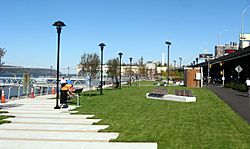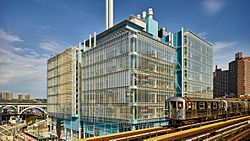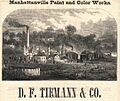Manhattanville, Manhattan facts for kids
Quick facts for kids
Manhattanville
|
|
|---|---|
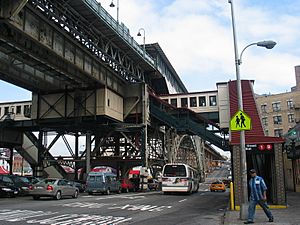
The 125th Street station (1 train) at Broadway and 125th Street, one of Manhattanville's primary subway stations. Visible on the signage is the former 9 train.
|
|
| Country | |
| State | |
| City | New York City |
| Borough | Manhattan |
| Community District | Manhattan 9 |
| Area | |
| • Total | 0.356 sq mi (0.92 km2) |
| Population
(2016)
|
|
| • Total | 40,568 |
| • Density | 113,960/sq mi (44,000/km2) |
| Ethnicity | |
| • Hispanic | 62.8% |
| • Black | 25.8 |
| • White | 7.5 |
| • Asian | 2.2 |
| • Others | 1.7 |
| Economics | |
| • Median income | $41,453 |
| Time zone | UTC−5 (Eastern) |
| • Summer (DST) | UTC−4 (EDT) |
| ZIP Codes |
10027, 10031
|
| Area codes | 212, 332, 646, and 917 |
Manhattanville is a neighborhood in the New York City borough of Manhattan. It is also known as West Harlem or West Central Harlem. The neighborhood is bordered by 135th Street to the north and 122nd/125th Streets to the south. To the west is the Hudson River, and to the east are Adam Clayton Powell Jr. Boulevard and the City College campus.
In the 1800s, Manhattanville was a busy place. It had a wharf for ferries and river boats. It was also the first train station north of the city on the Hudson River Railroad. Many stagecoaches and streetcars passed through. Its hotels and post office made it a popular spot to visit, away from the main city. Being close to the Hudson River also made it important for bringing building materials and other goods to Upper Manhattan.
Over time, as New York City grew, Manhattanville became more industrial. In the early 2000s, Columbia University started a big expansion project here. Columbia already has campuses in Morningside Heights and Washington Heights.
Manhattanville is part of Manhattan Community District 9. Its main ZIP Codes are 10027 and 10031. The New York City Police Department's 26th Precinct patrols the area.
Contents
History of Manhattanville
Early Days and Founding
The village of Manhattanville was started in 1806. It quickly became an important outpost for New York City. The village grew around the crossing of Bloomingdale Road and Manhattan Street. Today, this is roughly Broadway and 125th Street.
Wealthy merchants, many of them Quakers, helped plan the village's first streets. They had country homes in the area.
The village grew because Manhattan Street connected to the Hudson River. This easy access also helped the older village of Harlem grow, which was to the southeast on the Harlem River. Both Manhattanville and Harlem thrived in the 1800s as the two main villages in upper Manhattan.
Manhattanville is in a valley. During the Dutch Colonial period, it was called Moertje David's Vly (meaning "Mother David's Valley"). During the English Colonial period, it was known as Harlem Cove. This valley was also called the Hollow Way during the American Revolutionary War. The main part of the Battle of Harlem Heights started here, led by General George Washington. During the War of 1812, the southern hills of the valley were part of the Manhattanville Pass. This area had defense forts like Fort Laight and Blockhouse No. 4.
Manhattanville's early residents were a mix of people. They included American patriots and British loyalists. There were also slave owners and enslaved African-Americans, as well as Quaker anti-slavery activists and free Black abolitionists. Many people were connected to the same local groups. For example, St. Mary's Protestant Episcopal Church, founded in 1823, was the first Episcopal church to stop charging for pew rent in 1831. The Manhattanville Free School, started in 1827, is now Public School No. 43. Both are still in their original locations.
One of Manhattanville's most famous residents was Daniel F. Tiemann (1805–1899). He owned the D. F. Tiemann & Company Color Works. He was also the Mayor of New York City from 1858 to 1859. His factory moved to Manhattanville in 1832. It is now the site of 560 Riverside Drive.
Growth and New Residents
Manhattanville grew quickly as a popular place outside the city. In the late 1800s, many new homes, churches, hospitals, and businesses were built. New transportation options made it a good spot for breweries.
More people moved to Manhattanville in the mid-1800s after the Hudson River Railroad opened in 1850. Many Irish Catholic families arrived and started the Church of the Annunciation in 1854. German families also came and built St. Joseph's Roman Catholic Church in 1860. After the American Civil War, Jewish immigrants moved into the western parts of Manhattanville. They founded the Old Broadway Synagogue in 1911. Other important institutions from the 1800s included the Academy of Convent of the Sacred Heart (later Manhattanville College) and Manhattan College.
In 1904, the Interborough Rapid Transit Company (IRT) opened its new Broadway–Seventh Avenue Line. This subway line, now part of the 1 train service, changed Manhattanville a lot. It helped the area become part of the growing city by providing fast travel downtown. In the 1900s, immigrants from Cuba, the Dominican Republic, and Puerto Rico moved to the area. By the 1970s, Columbia University and Barnard College students and staff began filling the southern part of Manhattanville.
Since the late 1990s, West 125th Street has seen economic improvements. Many buildings south of 125th Street have become co-ops, meaning residents own their apartments. This shows that the area is becoming more popular and housing is in higher demand. The city has a plan for the 125th Street area. It aims to strengthen its role as a center for arts and culture.
Manhattanville in the 21st Century
University Expansions
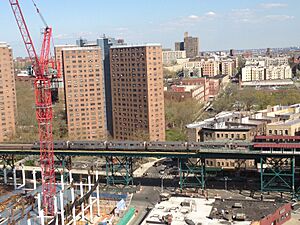

Manhattanville is where Columbia University is planning a big expansion. The university bought several blocks between 125th and 133rd Streets. They plan to build a new campus, a secondary school, and park land. The famous Italian architect Renzo Piano designed these new buildings. Some local residents worried about how this expansion would change the neighborhood. They were also concerned about the possible use of eminent domain, which allows the government to take private land for public use.
In 2006, Columbia built a new School of Social Work. In 2007, the New York City Council approved Columbia's plan for the area. Renzo Piano Workshop designed three buildings for the Manhattanville Campus, which were finished by 2018.
Other colleges have also built dorms in the area. To the north, The Towers dorm for 589 students was finished in 2006. It is an extension of the City College of New York. This was the first time City College housed students on its campus. The Manhattan School of Music also built a dorm around 2003. In 2006, the Jewish Theological Seminary of America opened a smaller dorm.
In 2009, City College finished building a new School of Architecture and Urban Design. This 135,000-square-foot (12,500 m2) building was designed by Rafael Viñoly Architects. It adds a modern look to the area's mix of old and new buildings.
West Harlem Piers Park
Construction of the West Harlem Piers Waterfront park started in 2006. The park was paid for by the New York City Economic Development Corporation. It includes a fishing pier, a kayak launch, sculptures, and water taxi landings. The park stretches from 125th Street to 132nd Street. It uses land that was once a parking lot. This park is part of a trend to turn old areas into public spaces, like the High Line and Brooklyn Bridge Park. The piers used to serve ferries to Edgewater, New Jersey. The park filled a gap in the Manhattan Waterfront Greenway, a path along the western side of Manhattan. It opened in October 2008. The area around the park is sometimes called ViVa (Viaduct Valley).
Arts and Entertainment
The arts scene in Manhattanville also grew. In October 2006, The Gatehouse Theater opened. It is part of Aaron Davis Hall, which focuses on dance performances. The theater was created by fixing up an old 19th-century Croton Aqueduct building. Both Aaron Davis Hall and the Gatehouse Theater are now known as Harlem Stage.
Manhattanville's Population
In 2010, Manhattanville had 22,950 people. This was a small decrease from 24,772 people in 2000. The neighborhood covers about 248.49 acres (100.56 ha).
The people living in Manhattanville come from many different backgrounds. In 2010, about 62.8% of the population was Hispanic or Latino. About 25.8% were African American, 7.5% were White, and 2.2% were Asian.
The average household income in Manhattanville was $41,453 in 2017. About 24% of people in the wider Community District 9 lived in poverty in 2018. This is higher than the average for all of Manhattan.
Important Places to See
Historic Churches and Synagogues
Manhattanville has four historic places of worship.
- St. Mary's Protestant Episcopal Church is on West 126th Street. It was started in 1823. This was the only church in the area for a long time. Its current stone building was built in 1908–1909. It replaced the original wooden church from 1824. In 1831, St. Mary's was the first Episcopal church to stop charging for pew rentals. You can see the marble seal for "Jacob Schieffelin's Vault" on the church porch. Jacob Schieffelin and his wife, who donated the land for the church, are buried there. St. Mary's is the oldest church in Harlem that is still in use on its original site. In 1998, the church, its parish house, and school building became a New York City landmark.
- Church of the Annunciation (Roman Catholic) is on Convent Avenue and West 131st Street. It was founded in 1854. This was the first Catholic church built on Manhattan's west side above 2nd Street. It served many Irish Catholic workers on the Hudson River Railroad. The current stone building was built in 1906–1907.
- Church of St. Joseph of the Holy Family was started in 1860. It was first called the Church of the Holy Family. Manhattanville's German Catholic community built it at 125th Street and Morningside Avenue. In 1861, it held what was probably the first public Corpus Christi procession in New York City. This church building is considered the oldest church building in Harlem.
- Old Broadway Synagogue is an Orthodox Jewish synagogue. It was built on Old Broadway in 1923. The congregation was formed by Jewish immigrants from Russia and Poland who moved to New York in the 1880s. The building is listed on the National Register of Historic Places.
Fire and Postal Services
Manhattanville has two New York City Fire Department (FDNY) fire stations. Engine Co. 80/Ladder Co. 23 is on West 139th Street. Engine Co. 37/Ladder Co. 40 is on West 125th Street.
Manhattanville uses two main ZIP Codes. The area south of 133rd Street is 10027. The area north of 133rd Street is 10031. The United States Postal Service has the Manhattanville Station and Morningside Annex at 365 West 125th Street.
Education in Manhattanville
Community District 9, which includes Manhattanville, has many college-educated residents. In 2018, about 49% of adults aged 25 and older had a college degree or higher.
The percentage of elementary school students who miss many days of school is higher in Community District 9 than in the rest of New York City. Also, fewer public high school students in Community District 9 graduate in four years compared to the city average.
Local Schools
The New York City Department of Education runs several public schools in Manhattanville:
- New Design Middle School (grades 6-8)
- PS 129 John H Finley (grades PK-8)
- PS 161 Pedro Albizu Campos (grades K-8)
- Teachers College Community School (grades PK-6)
- The Mott Hall School (grades 6-8)
- Urban Assembly Academy for Future Leaders (grades 6-8)
- Urban Assembly for the Performing Arts (grades 9-12)
Colleges and Universities
Columbia University has its Manhattanville campus in the neighborhood. This campus includes the Forum, the Lenfest Center for the Arts, and the Jerome L. Greene Science Center. The Henry R. Kravis Building and the Ronald O. Perelman Center are also being built.
Public Library
The New York Public Library (NYPL) has the George Bruce branch at 518 West 125th Street. It is named after George Bruce, an inventor. His daughter built the first George Bruce Library in 1888. The current three-story building was designed by Carrère and Hastings and built in 1915. It was updated in 2001.
Images for kids
See also
 In Spanish: Manhattanville (Manhattan) para niños
In Spanish: Manhattanville (Manhattan) para niños




